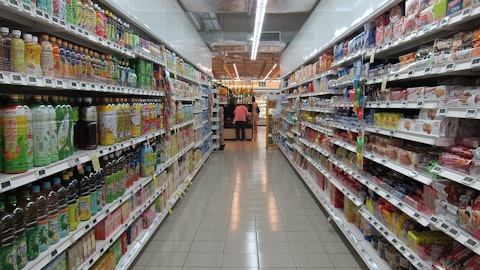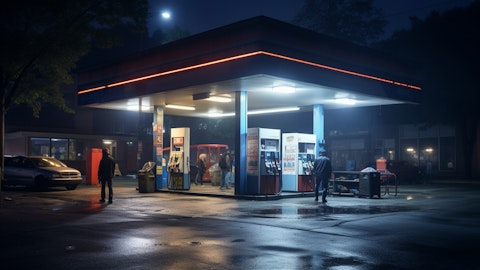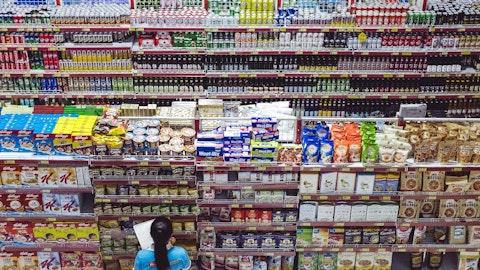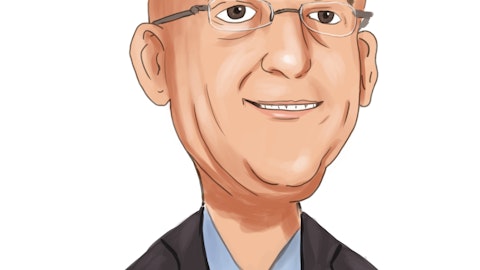Arie Kotler: Sure. Sure. So you probably saw, Kelly – I’ll start with the three pillars. Pillar number one, of course, is the loyalty. As you guys saw in 2023, we added over 730,000 members basically to our loyalty program. Just in Q4, and this is just an example, and Q4 this is not the biggest Q, but just in Q4, as you can see, enrolled members spent $12.70 versus non-enrolled members that spent $9.62 per transaction, which is approximately 32% more. This is an opportunity for us, and this is something that we’re going to continue to work really, really hard. We had a goal over here. The goal was to get to 2 million members, and we actually achieved our goal in 2023. As I mentioned, our goal is to get to 3 million members, and this is something that we are going to concentrate and work really hard.
I believe the pizza program, by the way, that I mentioned earlier, it’s a great opportunity. Just for everybody’s benefit, the whole pie pizza that we created over here for $4.99, it’s only for enrolled members. And if you’re not an enrolled member, you’re going to pay $7.99 per pizza. So we created the opportunity for enrolled members to come in the store and grab this great tasty pizza for $4.99. $3 difference, we believe, it’s going to create the opportunity for people to actually to enroll. So that’s, I think, the first pillar. The second one is, of course, the core destination. As you guys see, we continue to increase margin quarter after quarter. And the increase in margin is, of course, because of the basket. Our assumption that people are going to come in the stores and buy this great pizza and some other opportunity, like I mentioned, like the $2.99 for a chicken sandwich.
Just for everybody’s benefit, the chicken sandwich in convenience stores cost more than $2.99. The non-enrolled member are paying $3.99. And again, this is a great quality sandwich. And the idea is, again, how do we increase the basket. Going back to the core categories, we believe that with those items, as we get into food service and invest more time and having food service, we believe that the core destination will grow, which will grow, of course, the margin. And the last, basically, point was related to, of course, to M&A. We’re not going to slow down M&A, but we are going to, as I say, to concentrate probably on a little bit larger transaction to make sure that the team is not distracted. But as I said, my plan this year, 2024, Arie, is to spend more time in the stores, make sure that the food programs that we are putting in is basically going to tap into those opportunities that we see out there.
I believe that the increase in loyalty and loyal members over here is a tremendous opportunity for us to walk with those members. Our job is, of course, to provide value to those members. We’ve been doing that this year, and with that, we were able still to increase margin quarter after quarter, year-over-year. And if you go back, and I’m finished with that, if you go back just between 2022 to 2023, we were able to increase margin 140 basis points.
Kelly Bania: Can I just follow-up on the loyalty? You talked about the bigger basket sizes, which is impressive given the lower price points. But can you maybe parse out if there’s any traffic benefit from those loyal customers? Maybe just traffic versus customers on the loyalty program and then traffic for non-loyalty customers.
Arie Kotler: The loyal members are coming more often to the store versus the non-loyal member. And I think that would drive the traffic. That’s the reason why we keep saying that the loyal members are spending 32% more. But it’s not only spending more, it’s also basically coming more often to the store. And the reason they’re coming more often to the stores is because on a regular basis, on a daily basis, we send the loyal members – every enrolled members on a loyal basis is getting very valuable promotions that only enrolled members can actually get, and that’s what drives them. And this is right now, if you’re looking basically on the basket right now or on the trend, in 2021, when we basically just started, if you’re looking on our basically sales, which was around 13.9% loyal members, today it’s around 19.3%.
When it comes to basically to merchandise sales from a contribution standpoint, in 2021, the contribution just from – merchandise contribution just from loyal members was around 12.9%. Today it’s 17.6%, basically in Q4 ‘23 versus Q4 ‘21 when we just started. So we believe that not only they’re coming more often, they’re actually spending more because of that, and they increase the traffic.
Kelly Bania: Thank you. Can I just ask one more about fuel? I think the comment was that you’re planning for gallon demand at retail down about mid-single digit, and with the midpoint of the CPG range down about $0.01, that’s another 2%, so a high-single-digit decline in retail fuel profits from the same-store perspective. Do you see that just maybe 2024 is a year to get back to stabilization and then return to growth beyond that? Just curious as you look at the structural factors that maybe investors were expecting to drive fuel margins higher, are those still at play? Is there something else going on? Is it just a reversion year? Maybe just help us think about or understand how you’re thinking about that.
Arie Kotler: We are just at the beginning of 2024. And if you remember last year in 2023, we also saw Q1 with a lower CPG versus what we saw during the year. And because we are providing first time guidance right now, we can only talk about trend of what we see over the past six weeks to seven weeks. I can’t forecast the year. I don’t see any reason. By the way, this is my belief, Arie. I don’t see any reason for CPG to decline. I still believe that all of the operators out there, from a structure standpoint, everybody have the same expenses and everybody have the same issues dealing with expenses. So, again, given where we are today, based on the trend over the past seven weeks, that’s what we had to put out there. But again, I believe that things shouldn’t change basically from 2023.
I think 2022 was a very high CPG, a record CPG year of over $0.41 for the year. But at the end of the day, we finish 2023 $0.02 below, which is not significant. So, I don’t see any reason for those things to change. But again, it’s too early in the year. There are so many things can happen during the year, but that’s where I stand today.
Kelly Bania: Thank you.
Arie Kotler: Thank you, Kelly.
Operator: Thank you. Our next questions come from the line of Mark Astrachan with Stifel. Please proceed with your question.
Mark Astrachan: Yes. Hey. Thanks. Good morning everybody. I guess to start, maybe can you talk about the flow through impact of correlation from retail fuel gallons to the in-store merchandise sales.
Arie Kotler: In terms of?
Mark Astrachan: Well, in terms of just the correlation, right? It seems from the outside-in that if fuel gallons are weak, fewer people are visiting stores, and therefore, the merchandise sales in-store are weaker. Is that reasonable?
Arie Kotler: Not necessarily. Again, I mean again, what we are doing – just to be clear, we keep talking about optimizing gross profit outside, but I can tell you that we are absolutely focusing on our market share inside the store. So, by definition, when people are driving less, you have less people, of course, coming in. But I mean overall, this is an area that we concentrate. We are competitive outside. We are pricing fuel site-by-site, location-by-location, market-by-market. This is not going across the board. And the one thing that we are watching when we price fuel, while we are trying to maximize gross profit and optimize gallons, we are making sure that we are watching the trend inside the store. I believe that the market that we do business, I think I mentioned it last year, 40% of our stores are in town that have 20,000 people or less.
20% of our stores are in town that have 20,000 to 50,000 people. And again, some of those areas, rural areas, a little bit maybe low-income areas, and I think some of those people are just being impacted by the inflation. And that’s the reason why we are coming up with all of those valuable promotions. For example, pizza for $4.99, you can today feed a family for less than $10. And those are the things that we are concentrating and those are the things that we bring to market. And I think those are the things that are going to help us actually to grab more traffic inside the store.
Rob Giammatteo: And in market, say, if you look at the fourth quarter where we had a pretty large spread, right. The same-store sales were down low-single digits, the gallons were down high-single digits. So, our job is to figure out how we leverage the loyalty program, how we talk to our customers, how we continue to drive to the inside and control the things that we can control. And I think that’s what we are going to be focused on going forward.
Mark Astrachan: Yes, that’s helpful. I guess it’s really more getting at just whether the strategy that you have talked about in terms of managing the dynamics around fuel profitability and fuel volumes, and then obviously how that translates into in-store sales is the right one. Obviously, I respect that you are running a business at your company to do that. The stock obviously would suggest that there are challenges seen by the market, which isn’t necessarily the right or the wrong thing. It is what it is, right? It’s a report or the market is telling you, hey, maybe there is something going on here. I guess how do you balance that, your long-term strategy, what you have seen in the results and how that translates into the stock with whether you pivot to some extent on that strategy, or if none of that is correct, is it just partly the markets in which you operate?
Are you like talk about what you just said in terms of smaller cities, towns that you operate in, more economically sensitive consumers? Is it just this is what we all have to deal with because your consumer base is different than some of your competitors?
Arie Kotler: Sure. So, Mark, I have been around the block for 20 years, over 20 years in this industry. In this industry you have one quarter that is great, one quarter that is maybe not great, but at the end of the day, overall, you are looking on a full year. If you are looking on our company, year-over-year, we are basically down 3.5% from prior year 2022, which was a high record year of over $0.41 CPG. Everybody knows that was a high record year. At the end of the day, we managed the business. And as you can see, yes, fuel contribution is down around, if you are looking for the full year, $46 million. But at the end of the day, if you are looking on merchandise contribution inside the stores, we actually finished the year, sales excluding cigarettes, 2.5% for the year.
So, we can’t just watch one quarter or another. We will actually finish the year with 2.5% I mean basically same-store sales, excluding cigarettes. Including cigarettes, it was 0.4%. But the reason I keep talking about excluding cigarettes, and I think that’s something that the market needs to appreciate, this is what drives basically the margin. The margin is being driven by sales, excluding cigarettes. Everybody knows that cigarette consumption is down, and that’s by the way, one of the reason that quarter-after-quarter you see that the percentage of cigarette contribution inside basically our total contribution continue to actually to come down. And sales from other categories, which are the core categories that I mentioned, continue to increase.
At the end of the day, we manage the business on a yearly basis and coming off $0.414 per gallon year, we managed the business ending up with $290 million, which is only 3.5% below the high record year. So, I think we did a very good job on that.
Mark Astrachan: Okay. Thank you.
Operator: Thank you. Our next questions come from the line of Karru Martinson with Jefferies. Please proceed with your question.
Karru Martinson: Good morning. My apologies if I missed it, but did you give CapEx guidance for 2024, I heard some new store openings there?
Rob Giammatteo: No, we are not going to give CapEx guidance, it’s early in the year. And as Arie mentioned, we are working on a number of things internally. And so we want to give ourselves the time to fully develop that strategy. But I would expect we would be at or above prior year levels, so we are not issuing specific guidance on that front.
Karru Martinson: Okay. And then in terms of operating costs, I remember a few quarters ago, you had talked to the fact that just costs have gone up here. You have to grow the merchandise side of the business to offset that. And I was wondering what’s the opportunity there to see those costs come down as a percentage of sales or stabilize, and what’s the outlook for the markets that you serve.
Rob Giammatteo: I think if we look at OpEx for the year, I think it was fairly well managed, right, it’s around 2% or so for the year. So, I think we are doing a good job with that. I think we are managing our business to the trends that we see. We have seen the average wage rate, which was growing rapidly, is still growing, but at a lower rate. So, I think we are starting to see some of the normalization on that front. And again, we are just going to continue to focus on making sure we have the right labor for the demand in the stores. I think that’s an ongoing activity that we continue to work. On a larger scale, I think we haven’t talked about G&A. And I think there are – one of the reasons I think that I am here just starting to look at some structural opportunities on the G&A side as well.
So, I think one of the things we will be looking at is how we can leverage the margin that we do bring in on the expense side. And that’s going to be an ongoing activity through 2024.
Karru Martinson: Okay. And then just lastly, I would love to say that, hey, open up some locations here in New York, because the $2.99 chicken sandwich for loyalty members is an incredible bargain to us city dwellers. Thank you very much, guys.
Arie Kotler: Appreciate that. And maybe I can just comment on the NTI, because you mentioned NTI. And I think that’s going back to what I think the rest of the team actually asked earlier, including Kelly, about opportunities. And I just want to be maybe mentioning that. We have three NTIs. We are breaking down on the first one in the next few weeks. We have there NTIs for 2024. And one of the things that we have never discussed before, in all of those acquisitions that we did, a lot of those acquisitions came with additional land and additional opportunities. And this is the opportunity for us right now to tap into those opportunities that we bought in the past. That’s one thing. The other thing, as I mentioned, is the express store that we just opened on a Quarles location.
Remember when we bought the Quarles location over 1.5 year ago, which was a great deal for us, great transaction for us. Unmanned locations for diesel, 180 sites that we bought in July 2022, and we told people that our goal at the end of the day is to figure out a way how to tap into those unmanned location, how to tap our retail business, because the retail business bring a large contribution. We just opened an ExpressStop unmanned location on one of the Quarles stores in Richmond, Virginia. And the idea is to continue to expand those opportunities. The idea is to continue to expand retail, tap into all of those acquisitions that we did in the past and expand them with our loyalty, with our food service. Because at the end of the day, that’s what actually drives the margin, that’s what actually drives the contribution over here.
And I can tell you that we are laser focused on that, especially now in 2024, coming off so many acquisitions that we did over the past few years.
Karru Martinson: Thank you very much guys.
Arie Kotler: Thank you.
Operator: Thank you. Our next questions come from the line of William Reuter with Bank of America. Please proceed with your question.
William Reuter: Good morning. The first question, I know that historically, given that you do focus on the smaller markets, which, Arie, you highlighted in a previous response, there haven’t been tons of competitive openings. There are many c-store concepts that are pretty aggressively expanding at this point. Are you seeing any of those openings in your existing markets that are impacting certain stores?
Arie Kotler: I can’t talk about a certain store or talking just on a market. We are watching, of course, the market. We are seeing some competitors coming into different markets and some of them that we are operating, of course. But this is not something new to us. I mean, we always have competitor coming to some market. We are coming to some market as well. So I don’t see anything over here that is different than what we actually saw in the past.
William Reuter: Got it. And then my follow-up question, in terms of the store base, you mentioned you are not providing CapEx guidance for the year. But how do you feel about the health of the stores in general in terms of need for either remodels or changes to their size to allow them to offer some of these new merchandise products that you’re introducing?
Arie Kotler: So this is one of the things that I mentioned about Investor Day going and basically providing everybody our strategy. This is something we are evaluating at the moment. There is no question that we made our first heavy step into food service and we are going to continue to do that. And this is one of the things that we are evaluating. The idea is to invest in stores that we see potential and opportunities and this is something that we are going to present to everybody just a little bit later in the year.
William Reuter: Great. Look forward to that. Alright, that’s all from me. Thank you.
Arie Kotler: Appreciate that. Thank you.
Operator: Thank you. We have reached the end of our question-and-answer session. I would now like to turn the floor back over to Arie Kotler for closing remarks.



